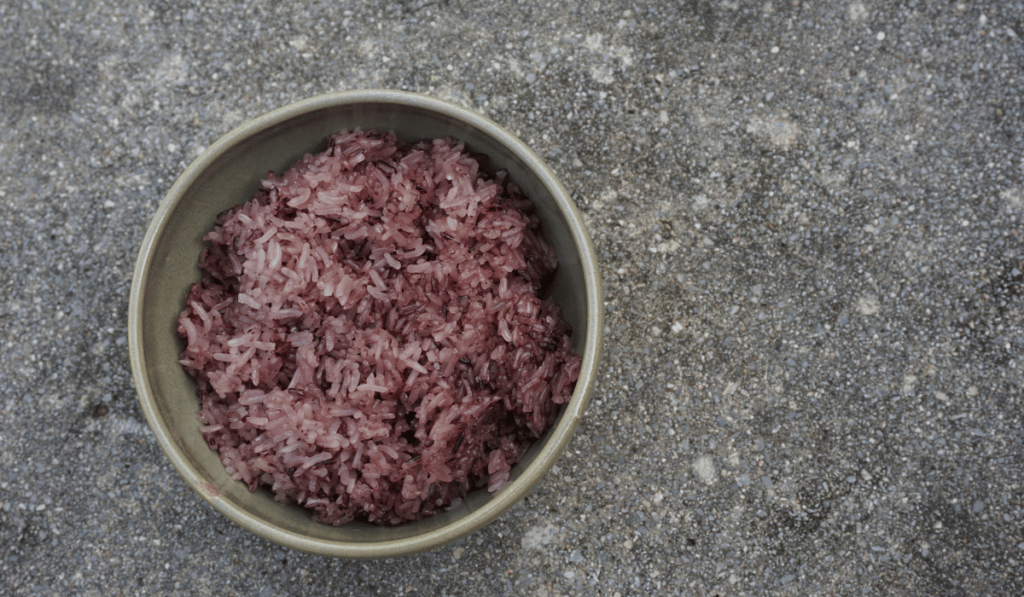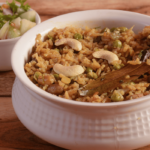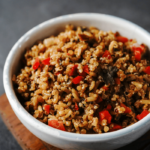The Best Fluffy Pancakes recipe you will fall in love with. Full of tips and tricks to help you make the best pancakes.
Table of Contents
ToggleHow to Cook Black Rice in a Pressure Cooker
Black rice, also known as forbidden rice, is a nutrient-packed ancient grain that offers impressive health benefits. With its high levels of antioxidants, protein, and dietary fiber, black rice is a superfood that can be easily prepared in a pressure cooker. In this comprehensive guide, we will walk you through the step-by-step process of cooking black rice in a pressure cooker, providing you with all the information you need to create a delicious and nutritious meal.
1. Black Rice
Black rice, also known as forbidden rice, is a highly prized variety of rice that originated in China over 2,000 years ago. It was called forbidden rice because it was believed to be so valuable and nutritious that it was reserved only for the emperor and royalty. In Chinese culture, black rice is also known as medicinal rice, offering rice, and longevity rice due to its healing properties and health benefits.
Black rice gets its dark color from the anthocyanin pigments found in its outer bran hull. These pigments are powerful antioxidants that have been linked to numerous health benefits, including reducing inflammation, protecting against chronic diseases, and promoting heart health.
2. Health Benefits of Black Rice
Black rice is not only visually striking but also incredibly nutritious. It contains higher levels of antioxidants, protein, and dietary fiber compared to other rice varieties. Let’s take a closer look at some of the health benefits associated with black rice:
a. Rich in Antioxidants
Black rice contains the highest level of powerful disease-fighting anthocyanin antioxidants among all rice varieties. These antioxidants help protect the body against free radicals and oxidative stress, reducing the risk of chronic diseases such as cancer and heart disease.
b. High in Dietary Fiber
Dietary fiber is essential for maintaining a healthy digestive system and promoting regular bowel movements. Black rice is an excellent source of dietary fiber, which aids in digestion, helps regulate blood sugar levels, and promotes satiety, making it a great addition to a balanced diet.
c. Substantial Mineral Content
Black rice is a good source of essential minerals, including iron. Iron is necessary for the production of red blood cells and the transport of oxygen throughout the body. Incorporating black rice into your diet can help prevent iron deficiency anemia and promote overall health and well-being.
d. Plant-Based Protein
Compared to other common varieties of rice, black rice contains more plant-based protein. Protein is essential for tissue repair, muscle growth, and overall cellular function. Including black rice in your meals can help meet your daily protein requirements, especially for individuals following a vegetarian or vegan diet.
e. Detoxification
Black rice is considered one of the healing foods that help cleanse the body of harmful substances. It aids in detoxification by supporting liver function and promoting the elimination of toxins from the body.
f. Naturally Gluten-Free
For individuals with gluten sensitivities or celiac disease, black rice is an excellent alternative to gluten-containing grains. It is naturally gluten-free, making it a safe and nutritious choice for those following a gluten-free diet.

3. Choosing and Storing Black Rice
When selecting black rice, it’s essential to choose a good quality product to ensure optimal taste and texture. Here are some tips for choosing and storing black rice:
a. Quality Indicators
Look for black rice that is slightly glossy and smooth, without any cracks. The grains should be relatively uniform in size and plump. When tasting the rice, it should have a slightly sweet flavor, without any sour or bitter notes. If you scrape off the bran hull, the inner grain should be white.
b. Storage
Store black rice in a cool, dry, and shaded area. It’s best to store it in a sealed environment, such as a ziplock bag or covered stainless steel container, to maintain its freshness and prevent moisture from affecting the grains.
ALSO READ: How to Cook Millet Rice
4. Preparing Black Rice for Cooking
Before cooking black rice in a pressure cooker, it’s essential to rinse the rice thoroughly to remove any impurities. Here’s how to prepare black rice for cooking:
- Place 1 cup (215g) of black rice in a colander and rinse it under cold running water. Use your hands to rub the rice gently and ensure all the grains are clean.
- Drain the rice well, removing excess water.
- Measure 1 cup (250ml) of cold water for every 1 cup (215g) of black rice. This is the recommended rice-to-water ratio for pressure cooking black rice.
5. Cooking Black Rice in a Pressure Cooker
Cooking black rice in a pressure cooker is a quick and convenient method that yields perfectly cooked grains. Here’s a step-by-step guide on how to cook black rice in a pressure cooker:
- Add the rinsed black rice to the inner pot of the pressure cooker.
- Pour in the measured amount of cold water, following the recommended rice-to-water ratio.
- Close the lid securely and ensure the pressure release valve is set to the sealing position.
- Select the high-pressure cooking setting on your pressure cooker and set the cooking time to 18 minutes.
- Once the cooking time is complete, allow the pressure to release naturally for 10 minutes.
- After the natural pressure release, carefully turn the pressure release valve to the venting position to release any remaining pressure.
- Open the lid carefully, and fluff the black rice with a fork.
6. Tips for Perfectly Cooked Black Rice
To ensure perfectly cooked black rice every time, consider the following tips:
a. Adjusting the Rice-to-Water Ratio
If you prefer a softer or stickier texture, you can increase the amount of water slightly. Conversely, if you prefer a firmer texture, you can reduce the amount of water. Experiment with different ratios until you find your preferred consistency.
b. Soaking the Rice
While soaking black rice is not necessary, some people find that it helps reduce the cooking time and improve the texture of the grains. If you choose to soak the rice, simply place it in a bowl, cover it with water, and let it soak for 30 minutes before cooking.
c. Adding Flavor
Black rice has a naturally nutty flavor that pairs well with a variety of dishes. Consider adding herbs, spices, or aromatics to the cooking liquid to infuse the rice with additional flavor. You can try adding a bay leaf, a cinnamon stick, or a few cloves for a subtle hint of fragrance.
d. Using Broth or Stock
For added flavor, you can substitute a portion of the water with vegetable broth, chicken broth, or mushroom broth. This will infuse the black rice with savory notes and enhance the overall taste of your dish.
7. Serving Suggestions and Recipe Ideas
Black rice is a versatile ingredient that can be enjoyed in various ways. Here are some serving suggestions and recipe ideas to inspire your culinary creativity:
a. Side Dish
Serve black rice as a nutritious and flavorful side dish alongside grilled chicken, roasted vegetables, or stir-fried tofu. Its unique texture and nutty flavor will complement a wide range of main courses.
b. Rice Bowls
Create vibrant and nourishing rice bowls by topping a bed of black rice with your favorite proteins, such as shrimp, salmon, or grilled tofu. Add a variety of colorful vegetables, a drizzle of sauce, and garnish with fresh herbs for a satisfying and balanced meal.
c. Salads
Add a nutritious twist to your salads by incorporating black rice. Its chewy texture and nutty flavor will provide a delightful contrast to crisp vegetables and creamy dressings. Try tossing black rice with mixed greens, roasted beets, goat cheese, and a tangy vinaigrette for a refreshing salad.
d. Black Rice Pudding
Turn black rice into a delectable dessert by making black rice pudding. Simmer cooked black rice in coconut milk, sweeten with a natural sweetener like honey or maple syrup, and add your favorite spices such as cinnamon and cardamom. Top with fresh fruits or nuts for a satisfying and indulgent treat.
8. Frequently Asked Questions
a. Can I cook black rice in a regular pot instead of a pressure cooker?
While cooking black rice in a pressure cooker is the quickest and most convenient method, you can also cook it in a regular pot. Simply follow the same rice-to-water ratio as mentioned earlier and simmer the rice over low heat until tender, typically around 30-40 minutes.
b. Can I freeze cooked black rice?
Yes, you can freeze cooked black rice for future use. Allow the rice to cool completely, then transfer it to airtight containers or freezer bags. Label the containers with the date and freeze for up to 3 months. Thaw the rice in the refrigerator overnight before reheating.
c. Can I mix black rice with other rice varieties?
Absolutely! Mixing black rice with other rice varieties can create interesting flavor and texture combinations. Experiment with different combinations, such as black rice and jasmine rice or black rice and wild rice, to add variety to your meals.
9. Conclusion
Cooking black rice in a pressure cooker is a simple and efficient way to enjoy this nutritious and flavorful grain. By following the step-by-step guide and incorporating the tips and suggestions provided, you can create perfectly cooked black rice that will elevate your meals and provide you with an array of health benefits. Whether enjoyed as a side dish, in rice bowls, or even in desserts, black rice is a versatile ingredient that adds depth and richness to any culinary creation. So go ahead and explore the world of black rice in your pressure cooker, and discover the joys of this ancient grain.




